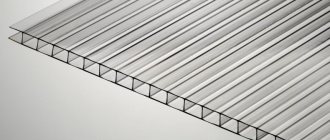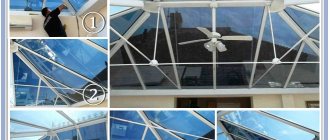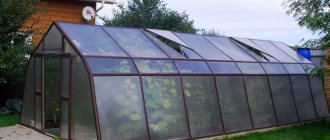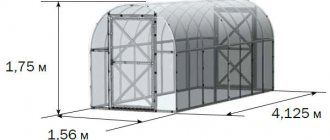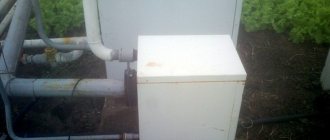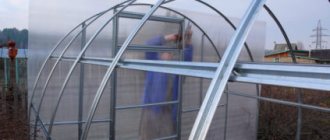Polycarbonate bodies, compared to conventional glass structures, in most cases look much more advantageous. As a rule, they not only have a neat shape, but are also made quite well, without visible flaws. However, in order to be not only beautiful, but also as functional as possible, such structures must have the best protection from various natural phenomena, including rain and wind. To enhance these parameters, a joining profile for polycarbonate is used.
Using profiles when installing cellular polycarbonate
Types and purpose of profiles for polycarbonate
There are several types of SOTAPLAST profiles and fasteners, the use of which is required by polycarbonate installation technology. Among them are connecting profile, end profile, corner connection, ridge connection. Installation of several polycarbonate panels occurs using connecting profiles; in this case, the joints are more reliable. They are sold in two types: detachable and one-piece profile. During the construction of small structures, cellular polycarbonate is connected to each other using one-piece profiles. Its length is six meters, there are special grooves on both sides where the sheets are inserted. Polycarbonate profiles are especially indispensable when creating rectilinear structures; they are easy to install and make work easier. To do the same thing, but with curved arched construction, the master has to put in a lot of effort. Inserting a sheet into an N-shaped profile is quite difficult; the screws have to be placed on top. Detachable connection profiles for polycarbonate will help simplify the task when using material with a thickness of 8 mm or more. They consist of two parts - a lid and a base. A cover is required to completely cover the connection. Such elements are mounted sequentially, first the base is fixed, then the sheet is fastened, after which the lid is snapped into place.
Fastening with glue
The joints of polycarbonate sheets on the roof surface are clearly visible. Visible joints can be avoided if silicone-based glue is used to join the sheets. You can successfully replace glue with solvents that contain methyl chloride or ethyl chloride.
Fastening polycarbonate panels using silicone glue will not leave a mark behind.
Using a mounting gun, the glue is applied in an even layer to the end surfaces of the sheets to be glued and dries in a very short time.
The adhesive seam firmly, hermetically and imperceptibly connects the panels, preventing moisture from entering the room. The joint surface and the panels lie in the same plane. The design with adhesive joining of sheets looks great.
Whichever of the proposed methods, subject to the installation rules, you join the sheets, the connection will be strong, airtight, and aesthetic.
Purpose and advantages of accessories
Fittings for cellular polycarbonate are necessary to ensure reliable fastening and joining of sheets and sealing of joints. Numerous components are presented in several versions, which allows you to choose the ideal solution in accordance with the color and type of polycarbonate roofing sheets, design features and requirements for external design. Most of the accessories are fastened with self-tapping screws or special locks - in this case, the base for them is also mounted using hardware.
Accessories for polycarbonate have a huge margin of safety and provide the following installation advantages:
- provide reliable fixation of sheets;
- protect them from damage;
- give a complete and aesthetically correct appearance to the structure;
- ensure tightness of joints and connections;
- eliminate cold bridges.
But it is very important to choose the right elements for polycarbonate - only in this case will the practicality, durability and visual appeal of the entire structure be achieved.
Fastening
When mounting polymer panels on the frame, the following operations must be performed for fastening:
- Cut the material using a hacksaw or a circular saw;
- Drilling holes using a drill;
- Tightening screws with a screwdriver or screwdriver;
- A hammer or mallet is needed to correct the correct placement of parts.
Types of extensions for polycarbonate sheets
It is worth noting that an important characteristic that unites all accessories is their high flexibility, combined with the plasticity of the material. At the same time, they are characterized by strength over a wide temperature range, resistance to moisture and direct sunlight. Conventionally, all types of accessories can be divided into the following:
- guides for polycarbonate. These include connecting, corner, wall and ridge profiles, end elements. Their main purpose is to connect roofing panels to each other or to other materials and surfaces, to protect corners and ends;
- sealing materials. Fittings of this type installed on polycarbonate are divided into sealing end and perforated tapes, AN seals. They are necessary to protect the polymer material from dirt and moisture, ensuring their additional fixation in the guides;
- fastening elements. These include thermal washers, clamping strips for polycarbonate, adhesives for polyurethane resins, and roofing screws.
The following accessories for polycarbonate are in greatest demand during installation work.
End profile
Its main purpose is to protect the end sections of polycarbonate panels from moisture and dirt. In addition, the aesthetic role of the element should not be diminished: closing the ends ensures the completeness and integrity of the structure.
U-shaped end fittings for polycarbonate are also used to connect sheets with a thickness of 4 to 25 cm. But it is important to choose the correct thickness of the end profile - otherwise the aesthetics and functionality of such connections will be noticeably reduced. It is also worth paying special attention to fastening - depending on the configuration, it is carried out using self-tapping screws, sealant or snaps.
Wall profile
A wall corner for cellular polycarbonate is necessary to ensure a tight connection between the roof and the wall. Wall corners that attach polycarbonate to external surfaces are highly elastic, yet quite durable and resistant to temperature and mechanical stress. Also often called an adjacent profile.
Corner profile
It is necessary for connecting polycarbonate sheets at angles of 30, 45, 60 and 90 degrees, but the most widespread is the rectangular profile. There are both polycarbonate and aluminum corners for polycarbonate. Regardless of the material of manufacture, corner profile accessories are characterized by lightness, flexibility, high strength and long service life. The fastening of the canvases is carried out in them by insertion and subsequent fixation with self-tapping screws.
Ridge profile
Structurally, it can be a semi-arch or a transparent polycarbonate corner. The main purpose of the extension is to connect panels in the upper part of the roof, providing protection from moisture and contamination. With temperature changes, it contracts and expands along with the main roofing material, which guarantees complete tightness of the connection.
Connecting profile
These components for monolithic polycarbonate are used to connect two different panels together and press them evenly onto the frame system. There are 2 types of profile available:
- One-piece. This is a monolithic product, attached to the base with hardware using the through-mounting method. A simpler option to install, but not intended for repeated removal and installation.
- Sectional. It consists of two parts: the bottom (called the base) and the top cover. The base is attached to the base using self-tapping screws or rivets. The cover is installed on top and secured with clamps. In this case, the sheets of roofing material are tightly pressed and securely fixed.
Detachable components installed on cellular and monolithic polycarbonate can be made of polymer or aluminum with additional rubber gaskets that ensure tightness.
Pressure bar
A clamping strip for polycarbonate is necessary for further fastening the sheets to the base. Its design is simple: it includes an aluminum strip and a rubber seal. In some cases it can be used as a connecting profile.
Sealant
To attach polycarbonate sheets to a metal frame, you should use rubber sealing material. Its main task is to increase the structural strength of the object as a whole, eliminating the appearance of creaks and other extraneous sounds during thermal expansion and contraction of the roof. It also provides additional sealing of joints. According to the technology, the seal must be mounted on all structural elements in contact with the polycarbonate coating.
We recommend reading: The roof is leaking in an apartment building, where to go, what to do if the roof is leaking in an apartment building, where to complain
Thermal washers
Accessories of this type installed on polycarbonate significantly simplify the process of installing sheet material. The advantages of using them are obvious:
- thermal washers do not prevent thermal expansion and contraction of the plastic, which eliminates the risk of roof deformation during the next change of seasons or sudden temperature changes;
- their use eliminates the risk of pinching the material with roofing screws during installation, which has a positive effect on the structural strength and durability of the roof;
- they simplify the process of installing a polycarbonate roof.
The design of thermal washers includes a leg, a silicone gasket and a lid. Currently, some manufacturers produce parts without legs, which eliminates the need to drill large holes in the sheet metal. When installing, you should follow the basic rule: the washer is tightly screwed to the roof, but without excessive pressure that causes its deformation.
Sealing tapes
Mounted on polycarbonate, components for this type of installation are designed to protect the joints and ends of the sheets from moisture and the accumulation of dirt. Tapes are available on rag and aluminum bases. There are no functional differences between them as such - all the differences lie only in the price of materials.
Fasteners
The main components for fastening monolithic polycarbonate, as well as cellular and profile-type materials are roofing screws. These are galvanized steel hardware with a wide head and a rubber sealing washer. Additionally, they can be coated with polymer paint, which allows you to choose the type of screw in accordance with the color design of the roof. Also, the fastening elements used to fix the end plates are glue for polyurethane compounds. It is moisture resistant and has a long service life, is easy to apply and gains maximum strength within 24 hours.
How to attach polycarbonate
Installation is carried out using the following fastening systems:
- self-tapping screws or bolts;
- special profiles;
- galvanized tie strips;
- others not provided for by technology.
The frame to which the sheets are to be attached must be prepared accordingly - treated against corrosion or rotting, painted. After installation, it will be almost impossible to reach hard-to-reach places.
Bolts and screws
This fastening method is the simplest - a hole is drilled in the sheet, then a self-tapping screw is screwed in perpendicular to the surface. Most often, screws with a diameter of 4.8-5.5 mm are used. They provide strength to the connection without weakening the frame structure. Through holes are prepared for the bolts.
For fastening to a wooden frame, wood screws are used; to a metal frame, metal screws are used. To compensate for temperature deformations, the diameter of the drilled hole should be 2-3 mm larger than the cross-section of the hardware. It is also necessary to leave a gap of at least 5-8 mm between the sheets.
Thermal washers made of polypropylene, stainless steel or rubberized plastic help increase the tightness of the connection. Their design resembles a mushroom cap with a stem for hardware, a seat for a seal and a lid. The thermal washer reliably protects the connection from moisture and prevents over-tightening of the screw.
Record holders for durability are stainless washers, whose service life is unlimited. Products made from polycarbonate cope with the task for up to 20 years; in last place are polypropylene elements, which are prone to destruction from UV radiation.
Connecting profiles
To attach polycarbonate to the frame, as well as joining sheets together, profiles made of aluminum or polymers are used. They come in different shapes and designs:
- simple or compound;
- corner, wall, end, ridge.
During installation you need to perform the following operations:
- Attach the lower part of the profile - the base - to the frame.
- Prepare the edge of the sheet - peel back the protective film from the top side and remove it completely from the bottom.
- Seal the ends with sealing tape. For the upper cut, a solid one is used, for the lower one, perforated, so that condensation can flow freely.
Insert the profile sheet until it clicks (in simple designs) or cover it with the second part of the fastening element on top (in composite ones) and screw it to the frame with self-tapping screws.
With this installation method, the connections are neat, and most importantly, there is no damage to the sheet itself, which significantly extends the service life of the polycarbonate.
Galvanized strapping tape
Using such fasteners, you can cover a small arched structure, for example, a greenhouse or greenhouse. The sheet is pressed with tape to the frame and screwed with roofing screws to the arches and the lower chord. In this case, there is no risk of the polycarbonate being pressed through by the fasteners with a maximum tight fit.
Tensioning tapes are available in the form of cut strips or clamps equipped with threaded ties that provide a tight tension. If two sheets are joined without support, a perforated joining tape is used. It is applied to the edges of the panels from below and above, then both parts are connected with bolts.
other methods
Sometimes in private construction they use overlapping sheets, fastening with “earrings”, wire clamps, etc. These methods are not provided for by the technology of using the material, so the consequences may be unpredictable.
Since there is no necessary tightness of the connections, the joint will be blown out. In addition, due to temperature fluctuations, deformation of sheets and even destruction of polycarbonate are possible, which does not indicate poor quality of the material, but non-compliance with installation rules. The manufacturer does not provide any guarantees in these cases.
Types of connecting profiles
During installation, polycarbonate sheets are not simply attached to the load-bearing frame profiles, but are inserted into special aluminum or plastic profiles that guarantee the integrity of the structure and the absence of leaks at the joints. The joining strip for polycarbonate itself serves only to fasten polycarbonate sheets and does not act as a load-bearing element. The connecting parts have all the advantages of cellular polycarbonate:
- ease;
- flexibility;
- tightness;
- ease of assembly.
Depending on the final purpose of the assembled structure, several types of strips and profiles have been developed.
Permanent connection elements for polycarbonate
These parts are cast from plastic and are significantly less expensive than split strips. Most often used to create a hermetically sealed joint between panels in curved or straight structures. In operation, the one-piece element requires more attention and skill, because During installation, it is necessary to correctly “drive” the polycarbonate sheets to be joined into the side pockets.
Due to its small thickness, permanent fasteners allow you to create an invisible connection without protruding bumps or refraction of the architecture. Connection strip for polycarbonate
most often used to assemble thin parts from the same material.
Detachable docking strips for polycarbonate
This type of fastener is made of plastic or aluminum and consists of 2 elements: a base and a cover with a special configuration. Both parts are secured to each other using a special lock. Detachable strips for polycarbonate are more convenient to use and offer expanded functionality.
At its core, the joining profile of a polycarbonate clamp is not a direct part of the frame and cannot be used as a load-bearing element. The aluminum strip for polycarbonate, on the contrary, partially takes on the load from the frame and adds strength to the main frame.
According to the instructions, permanent fasteners are ideal for connecting polycarbonate sheets 6-8 mm thick. To connect 25 or 16 mm panels, it is best to give preference to detachable connecting strips for polycarbonate made of aluminum or plastic. When assembling, it is very important not to use excessive force, because... The clamp lock connecting the base and the cover may be damaged.
Advantages of polycarbonate profiles PLASTILUX-GROUP
The shape of each polycarbonate structural profile was carefully developed by leading PLASTILUX-GROUP technologists based on accurate load calculations, taking into account practical recommendations from clients. All products are UV stabilized and have special recesses for draining rainwater. The optimal width and angle of contact of the shelf in the ROYALPLAST and SANEX joining profiles allows you to insert up to 2 stiffening ribs under the fixing zone and guarantee a sufficient contact area. This ensures the correct functioning of the polycarbonate profile, the reliability of the connection and complete protection of the edges of the sheet. At the same time, there is an advantage - reducing the cost of the structure and creating additional aesthetic value of the transparent roof.
Consumer properties of PLASTILUX-GROUP polycarbonate profiles:
- improved lamella shape;
- correct angle of contact, high-quality sealing of the panel;
- increased contact area, reduced pressure on the sheet;
- optimal dimensions of the profile shelves, ease of assembly of the structure;
- special softness and elasticity of the lamellas, ease of installation;
- maximum profile length 12 meters, full protection of sheet edges;
- excellent performance characteristics - service life 20 years;
- wide basic palette - 12 profile colors.
HP polycarbonate connection profile (one-piece)
The connecting one-piece profile for cellular polycarbonate is used for joining together polycarbonate sheets with a thickness of 4mm, 6mm, 8mm, 10mm, 16mm. It has various trade names: PN, PSN, one-piece polycarbonate docking profile, H-shaped connecting profile. It is a long flexible strip of H-shaped section, the shelves of which are bent inward on both sides.
It is used to connect panels in flat structures, as well as on a single-pitched, gable or arched roof, according to the established bending radii. It is not a mounting profile and is not intended for attachment to roof supporting structures. Ensures correct joining of sheets and drains rainwater outside the roof. Profile length – 6m, 9m, 12 meters. The profile color is transparent, the basic palette is 12 colors.
Application of one-piece profiles for polycarbonate
One-piece profiles are less expensive, but joining polycarbonate using them has some difficulties, especially in windy weather. The installation itself is quite simple: first, the N-shaped profile for polycarbonate is expanded, and then the sheet is fed into it. As a rule, it fits into the groove with difficulty, so often to install it, the sides are retracted using a screwdriver or similar tool, and after that the panel is slowly pushed into place. This method is complex, so it is used only where free space is limited.
However, there is an easier way to install one-piece panels. Before installation, the edges of the installed elements are lubricated with some dishwashing detergent. As a result, the sheet will slide freely into the groove, and the remaining substance will simply dry out and will not break the seal of the joint.
In any case, regardless of the installation method, panels installed using permanent connectors should not reach the base of the groove - a small gap must be left at this point, which will allow the material to expand freely under the influence of temperature.
In addition, when using a one-piece connecting profile for polycarbonate, you need to make sure that all panels have the same thickness. The dimensions of the joining profile for polycarbonate are initially designed for very specific dimensions of the sheets being mounted. Products that are too thin will not allow the joint to be sealed, and products that are too thick will not be able to fit into the groove.
Application of detachable connection profiles
The technology for installing detachable connections does not look the same as in the previous case. The detachable connecting profile for polycarbonate includes two strips: the bottom one is attached to the frame of the structure, polycarbonate sheets are installed on its sides, and after that the structure is closed with the upper part of the split profile, which presses the parts to be connected.
Considering that the sheets must be fixed hermetically, their edges must be sealed with micropores and covered with silicone-based sealant. The sealant must be applied using a special gun so that a strip runs along the bottom edge. The same operation must be repeated with the upper part of the structure, before installing the upper part of the connecting profile.
Before snapping the top strip into place, it is advisable to fix the panel - this will simplify installation, since the strip will be stationary and all the necessary gaps will remain. Sheets are best fastened using self-tapping screws and rubber gaskets, due to which the dimensions of the split profile for polycarbonate can be changed.
Profitable and convenient cooperation
offers convenient terms of cooperation for buyers: individuals and legal entities, we also work with budget organizations
You can purchase goods directly from the Alexandria company warehouse or arrange delivery. We organize delivery throughout Moscow and the Moscow region, and also send goods to the regions through transport companies. ALEXANDRIA guarantees good quality of goods, accurate delivery, and offers convenient terms of order and payment.
To buy materials at a favorable price, you can make a purchase online, call a company employee at +7 (495) 021-91-01 or request a call back. We will contact you to clarify the details and confirm the purchase.
Using end profiles
To cover the sheets, end polycarbonate profiles of two types are used - L-shaped and F-shaped. The first option visually resembles guides for plastic sheets. This type of connecting profile is used exclusively for cellular thermoplastic, preventing moisture and contaminants from entering the pores of the panels. The second option also resembles guides of the corresponding shape.
The scope of application of plugs is determined by the individual design features:
- To assemble greenhouses, L-shaped plugs are most often used, which help protect the edges of the sheets buried in the ground;
- When arranging roofs, you can use any type of plugs, selecting them depending on specific tasks.
The role of plugs in maintaining the integrity of the structure is very important if honeycomb sheets are used to create it. Over time, moisture entering the internal cavity of the honeycomb sheets begins to turn into steam, due to which the transparency of the polycarbonate is significantly reduced. If you do not cover the polycarbonate profile with plugs, then in the future it will be almost impossible to remove water from the internal cavities of the sheets. In addition, it is advisable to seal such profiles hermetically using a film with micropores.
We recommend reading: Timber roof - we build a roof the old fashioned way
Structure, types and features of polycarbonate panels
Polycarbonate is a thermoplastic material based on Bisphenol A. The marking of the material is quite simple: the polycarbonate itself is designated by the letters PC, and additional marking symbols allow you to determine the characteristics of the sheets. The numbers present in the markings allow you to find out the maximum fluidity of the material.
Two types of polycarbonate panels are used in construction:
- Monolithic . This material is actively used in the installation of windows, transparent roofing structures, various partitions and systems of complex configurations. Monolithic polycarbonate in its performance characteristics is very close to ordinary glass, which determines the scope of its application.
- Cellular (cellular) . This type of panel consists of two elements that are connected using homogeneous partitions. The void present in the inner surface of cellular polycarbonate significantly increases the energy-saving properties of the material, so it can be used in structures that are demanding on the level of thermal conductivity of materials.
Increasing the thickness of monolithic products increases their volume, but the thickness of cellular panels increases due to the number of layers - there can be not only two, but three, and even more. The voids located between the layers can have the shape of any geometric figure. However, despite the differences between different types of material, they can be joined together using a starting profile for polycarbonate or suitable adhesives.
Installation requirements
When installing polycarbonate sheets, you must take into account the following rules to create a high-quality and reliable structure:
- It is best to assemble polymer structures at an ambient temperature of 10 to 22 degrees. At this temperature, the sheets will not be subject to deformation, which helps prevent leaks in the assembled structure.
- When using aluminum profiles to connect polycarbonate sheets, it is necessary to use compensation spacers. The problem lies in the different degrees of thermal expansion of thermoplastic and aluminum, which is compensated by rubber or silicone products.
- Before sheathing the future structure with polycarbonate, you need to assemble a frame made of wood or metal.
- The fastening pitch of the profiles must be calculated so that it coincides with the width of the polymer sheets - this will create the most rigid connection of all structural elements.
- Sheets with a honeycomb structure are arranged vertically to make them easier to bend. UV protection, if any, should be located on the outside of the structure.
- It is advisable to stick a film with micropores under the connecting profile for cellular polycarbonate, which will significantly improve the reliability of the connection.
- When using one-piece connecting profiles, you must first make sure that the thickness of the sheets corresponds to the dimensions of the grooves.
general information
Polycarbonate is a polymer plastic in its structure. Its undoubted advantage is the high level of protection against temperature changes and exposure to ultraviolet radiation. Thanks to this, it is actively used in a variety of climatic zones and conditions, but the strengths of the material are fully revealed only if the installation technology is followed. First of all, this concerns the joining and fastening of sheets to each other; moreover, this will make it possible to carry out repairs to the building without any problems or complications in the future, if the need arises.
Advantages of a polycarbonate roof
Among the advantages of polycarbonate sheets used for roofing are:
- Excellent decorative qualities, which not only give the structure a good look, but also visually enlarge the room;
- Cellular polycarbonate allows you to improve the thermal insulation qualities of a building (for example, a greenhouse or enclosed space);
- If necessary, you can select sheets with ultraviolet protection, which will protect the structure from sunlight;
- Honeycomb polymer sheets are lightweight, so their installation does not require a reinforced frame;
- The smooth surface of polycarbonate ensures independent drainage of precipitation and contaminants from the coating;
- The cost of polycarbonate is an order of magnitude lower than the cost of impact-resistant glass with similar characteristics;
- The energy-saving characteristics of polymer products allow you to save some money on heating;
- Like any plastic products, polycarbonate sheets have a long service life, which also increases the durability of the structure as a whole.
Conclusion
The connecting profile for polycarbonate is quite convenient, so you can use it even if you have no experience in construction work. The advantages of such profiles make them a very profitable purchase.
Nuances of choice
Nowadays, stores offer a wide range of different profiled polycarbonate boards
To choose a suitable material, first of all you should pay special attention to the weight of the sheet - it should be less than that of glass structures. In addition, high-quality polycarbonate must have good light transmittance and evenly disperse the sun's rays. When cold, the sheets can be bent to obtain the desired shape without the risk of damage
Properly manufactured polycarbonate is fire-resistant, can withstand strong wind and snow loads, is impact-resistant and does not change its characteristics in conditions of high and low temperatures.
When cold, the sheets can be bent to obtain the desired shape without the risk of damage. Properly manufactured polycarbonate is fire-resistant, can withstand strong wind and snow loads, is impact-resistant and does not change its characteristics in conditions of high and low temperatures.
Carefully inspect the product you are purchasing - there should be no dents, scratches or chips on it. Air bubbles, unevenness and delamination are not allowed. The stiffeners must be positioned at an even right angle; the presence of waviness indicates non-compliance with the production technology.
The main advantages of working with joining profiles
- Simplicity. Even novice builders do not have any difficulties working with polycarbonate panels and profiles. Any adult can assemble the structure he needs using the included instructions.
- Tightness. Docking profiles not only provide reliable joints, but also perfectly seal them, protecting them from condensation, moisture and the appearance of fungi.
- Lightness of design. Due to the airiness of the material itself and its honeycomb structure, large sheets weigh practically nothing.
- Speed. The ease of assembly significantly speeds up the construction time.
- Ease of dismantling. If necessary, the joining profile can be easily unscrewed and dismantled, and the polycarbonate sheet can be replaced as needed.
- Finished look. Plastic walls or roofs look much more interesting and tidy if there is a joining profile.
- Saving. You can assemble a polycarbonate structure yourself without the use of special equipment or tools. This significantly reduces the cost of purchasing them and wages to workers.
To more securely connect multiple parts, several configurations of polycarbonate end strips have been developed. Each of them is assigned a letter designation, these are UP, HP, RP, SP and FP.
The English P stands for Profile, and the second stands for the type or purpose of the element itself.
End strip for polycarbonate or UP profile
Used to protect the ends of cellular polycarbonate panels from moisture, fungus, condensation and dust. The length of the end tape is 210 cm, which completely matches the length of the polycarbonate sheet. The end strip gives the entire structure a finished look.
Junction strip for polycarbonate
Designed for fixing canopies, awnings, etc. to a wall or other surface. Initially, the profile is attached to the wall using a load-bearing frame element in the form of an angle, beam or square pipe. In appearance, the detail in profile resembles the Latin letter “F”.
Ridge connection strip for polycarbonate
Designed for installation of pointed or gable roofing structures made of panels at an angle of 90 to 150 degrees. The powerful grip of the polycarbonate fastening strip reliably and hermetically fixes both roof slopes and protects against temperature deformation during operation during changing weather seasons.
Corner additional elements for polycarbonate
Designed to discreetly attach polycarbonate sheets at right angles. This type of connecting strip is widely used in the advertising industry for assembling display stands and exhibition structures. A special feature of the corner tape is the presence of 2 grooves for inserting plastic panels. The corner connection strip for polycarbonate is designated by the abbreviation FP.
Today, manufacturers of polycarbonate structures offer a very wide selection of colors, sizes and configurations of plastic products. For example, from Polygal you can buy, along with sheets of cellular polycarbonate, the entire range of necessary components for installing a reliable and durable structure.
Manipulations with sheets during installation
During installation or cleaning, polycarbonate sheets should not be subjected to human weight. It is necessary to use temporary wooden beams or other devices on the basis of part of the roof structure (the board or screen must be at least 50 cm wide) on the construction site for movement. The polycarbonate surface is very sensitive to mechanical stress. Abrasive substances form at the contact point, friction of rough surfaces occurs and scratches appear. Try not to subject the material to such tests, and if possible, keep the surface protective film on until the end of the work. For the reason stated above, despite its strength, polycarbonate without a special hard varnish coating cannot be used as floor structures (podiums, stairs, stages with internal lighting, etc.). You should clean the plastic protective film immediately after installation. Otherwise, if exposed to the sun for a long time, the polyethylene may stick to the surface of the sheet and its further removal will be problematic.
Basic requirements for installing polycarbonate structures
When assembling sheets of cellular polycarbonate, you should strictly follow the instructions and equip workers with everything necessary. This is the only way to install a durable, airtight and reliable structure.
- It is best to work with plastic at positive temperatures from 10 to 22 degrees. If the indicators are different, polycarbonate sheets may become deformed, which will complicate installation and compromise the tightness of the structure.
- Before you begin assembling the polycarbonate structure, you need to assemble the initial metal or wooden frame.
- The fastening pitch of the profiles must be adjusted to the width of the polycarbonate sheets. This will give a stronger and more rigid articulation of all elements.
- When using aluminum strips, be sure to insert expansion spacers when connecting polycarbonate panels. Depending on weather conditions, thermoplastic and aluminum expand differently, which is mitigated by silicone or rubber gaskets.
- If there is a bend in the structure, sheets with a cellular structure should be placed horizontally and vertically. This will simplify the work and make the bend more resistant to the pressure of natural precipitation.
- It is strongly recommended to lay a tape with micropores under the connecting profile, which significantly increases the reliability of the connection of the nodes.
- Before installing the structure, it is imperative to make sure that the thickness of the polycarbonate sheets used corresponds to the grooves of the connecting profiles.
We recommend reading: Bikrost technical specifications
If you have chosen to use polycarbonate, then you should give preference to products that best meet the specified conditions:
- ambient temperature is not subject to correction;
- room temperature - initially set according to standards;
- design loads on buildings vary depending on the region;
- design and personal taste.
And the most important thing is the quality of the material used. It is best to give preference to products from manufacturers such as Polygal. They provide a ten-year warranty on their products with a service life of at least 25 years. Recommendations for transportation, installation and storage, tested by time and thousands of builders, inspire unlimited confidence in the branded product.
Connection profile for polycarbonate
The joining profile for polycarbonate is an indispensable material that is used for the construction of lightweight structures, for example, greenhouses. The plastic connecting profile for polycarbonate allows you to achieve the tightest possible connection of sheets without the use of self-tapping screws with thermal washers. In addition, this version of fastening elements allows you to compensate for the temperature during heating under direct sunlight, as a result of which the panels may undergo deformation. A special feature is the fact that this type of material bends well, which allows it to be used for the construction of arched structures.
Detachable connecting profile for polycarbonate
The detachable connecting strip for polycarbonate, made of plastic, consists of the following elements:
- the lower fragment, which is called the base;
- top cover, which must be attached to the base.
A detachable plastic product must be installed according to the following step-by-step algorithm:
- The first step is to install and then secure the lower part of the plastic connecting product to the frame using self-tapping screws. Fastening must be carried out pointwise along the central channel, maintaining a distance of 30 cm to 50 cm.
- After this, the polymer panel is laid with its end part on the lower surface of the fragment, while a gap of about 2-3 mm should remain between the vertical wall and the edge of the material.
- The connecting structure element is mounted on the second side of the panel, after which point fastening is carried out on the supporting base, and a temperature gap must be left.
- Fastening is carried out using self-tapping screws with thermal washers.
- Using a similar method, work with the next sheet.
- A plastic product is installed at the joining points, after which the top bar is aligned, which should snap into the grooves after several gentle blows with a hammer.
It is recommended to make a hole in the bottom of the plastic product to drain condensate.
Attention! A split profile for polycarbonate is recommended for use in cases where it is planned to build an arched structure.
One-piece connecting profile for polycarbonate
If necessary, you can connect the polycarbonate with a one-piece profile. To do this, you will need to insert the polymer material into the grooves of the plastic product. A self-tapping screw must be installed across the center line on the central channel, which is located between the walls. The self-tapping screw is installed to a depth equal to the sheathing, approximately 5 mm. When connecting several parts, it is recommended to leave a gap of 2 to 3 mm between the end surface and the wall of the product. This approach will compensate for temperature changes.
During installation work using a one-piece plastic element, you must adhere to the following instructions:
- it is necessary to install the end of the polymer material into the connecting profile;
- using a similar principle, fastening is carried out from the second end;
- after that, check how the sheet is positioned;
- the outermost connecting fastener is securely fastened;
- the end side of the second panel is placed in a free groove of the plastic product;
- fixation is carried out using self-tapping screws with thermal washers;
- install and secure the upper part of the profile;
- an end profile and punched paper tape are attached to the edges;
- make special holes for condensate to escape.
Many people recommend sealing the polycarbonate from the end with tape and applying machine oil to ensure smooth sliding.
Methods for joining sheets
There are 3 main methods by which polycarbonate sheets are joined together. The first two methods involve gluing and fixing the material using a profile, which is quite easy to do even if you have no experience in carrying out such work. In the third case, the sheets are joined during thermal fastening, which is much heavier and requires the appropriate skills to do it yourself in practice.
Fixing polycarbonate by gluing
This method makes it possible to mask connection points.
During the work carried out, a special adhesive composition is used, which is applied using a gun. It is highly undesirable to carry out this process manually. For reliable gluing, you should resort to the use of silicone glue, which is designed specifically for this task.
In addition to it, you can use other compounds, for example, solvents based on methylene chloride, ethyl chloride, or mixtures thereof. Any of these means, subject to gluing technology, allows you to give the mounted structure not only an attractive appearance, but also ensure the creation of full waterproofness and thermal insulation.
Thermal fastening and joining of sheets using a profile
Giving preference to this method, it is necessary to strictly observe the temperature regime and other stages of work in the correct sequence with all the important nuances. In this case, the joining of polycarbonate is carried out as follows: you first need to heat the joints of the two sheets to the required temperature, after which the two blanks are automatically placed in their intended place. If during further operation the structure will interact with climatic precipitation, then during fixation it is imperative to make small gaps.
Initially, the sheets have standard dimensions, which is why, before installation, in most cases it is necessary to cut the material into pieces of the required dimensions. This work is not difficult and during its implementation it is better to cut polycarbonate using an electric jigsaw, circular dust, a grinder or an ordinary hacksaw.
The profile connection of sheets to each other also has its own characteristics. When carrying out work, in addition to the saw, you will need to have special fasteners for the profile, which have standard dimensions, thanks to which the installation process becomes much easier. One of the difficulties lies in correctly calculating the required amount of these fasteners. For this reason, it is necessary to first determine the number of future bends and angles in order to ultimately achieve the most reliable fixation.
The sheets must be connected to each other on an open, flat surface. For example, a carpenter's table is well suited for this purpose. When using separate profiles, it is necessary to make a special strip. It is desirable that it consists of wood and must be even. When constructing a greenhouse, it is optimal to use the point fastening method using thermal washers and self-tapping screws. This method is simpler and more comfortable, making it more comfortable to use when constructing various arched structures.
Ridge profile for polycarbonate
As practice shows, a plastic ridge profile for installing polycarbonate is used in cases where it is planned to build greenhouses. This product option allows for a hermetically sealed connection of all joints. In addition, the ridge type is perfect in cases where an arched greenhouse is required, and the standard length of the polycarbonate sheet is not enough to cover the length of the entire arch.
Polycarbonate sheets must be inserted into the grooves of the plastic product on both sides. Thanks to the high level of elasticity of the material, the fixation is as reliable as possible. Since the material will expand during temperature fluctuations, a gap of about 3-5 mm must be left.
Important! The plastic fastening element has a length of 6 m. This type of product is used for polycarbonate with a thickness of 4-6 mm, 8-10 mm, 16 mm.
Wall profile for polycarbonate
Often, work may require, in addition to a clamping profile for polycarbonate, a wall type. A wall-mounted plastic profile is an excellent option when you need to join polycarbonate material to the main walls of a building. For example, when it is planned to install slopes for wall-mounted types of greenhouses, choosing this option allows you to obtain a high level of thermal insulation of the joint and prevent moisture from getting between the slope of the building and the wall of the building. The length reaches 6 m, the thickness can be from 6 to 10 mm.
Advice! If necessary, you can find a polycarbonate profile on sale.
What does a detachable “lid” profile look like – photo
Polycarbonate profile HCP-U cover transparent Polycarbonate profile HCP-U cover bronze Polycarbonate profile HCP-U cover green Polycarbonate profile HCP-U cover blue Polycarbonate profile HCP-U cover white-matte Polycarbonate profile HCP-U cover orange Polycarbonate profile HCP-U cover turquoise Polycarbonate profile HCP-U cover yellow Polycarbonate profile HCP-U cover amber Polycarbonate profile HCP-U cover garnet Polycarbonate profile HCP-U cover bronze-gray Polycarbonate profile HCP-U cover red
Corner profile for polycarbonate
If necessary, you can find not only a plastic U-shaped profile for polycarbonate on sale on the goods market, but also a corner one. As practice and reviews from many consumers and specialists show, plastic corner material for polycarbonate sheets is designed to mat the material in a perpendicular position. The profile has several grooves located perpendicularly into which the polymer material is inserted and held.
It is worth taking into account the fact that there must be a gap of about 5 mm. For greenhouses, corner fasteners are used in cases where it is necessary to ensure maximum tightness between materials at an angle of 90 degrees, for example, when joining a roof slope. If we consider the standard dimensions, the length is 6 m, and the thickness can vary from 6 mm to 10 mm.

